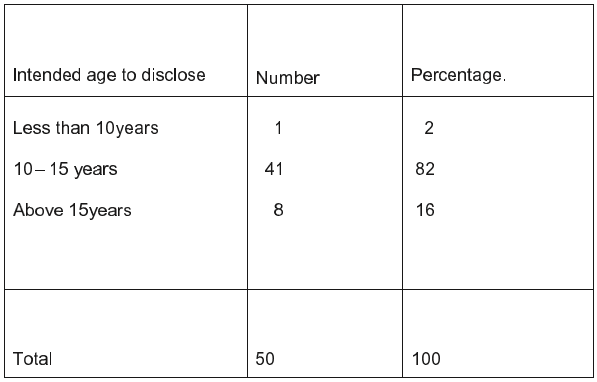Age at disclosure of HIV infection amongst children attending the Paediatric HIV care and treatment clinic of the Federal Medical Centre Owerri, south eastern Nigeria.
Abstract
Background: with easier access to life saving antiretroviral drugs, children with HIV/AIDS now have better life expectancy and informing them of their status has become of exceeding importance.
Objectives: this study set to assess the age at which HIV infected children attending the Paediatric HIV care and treatment clinic of the Federal medical centre Owerri, were informed of their status.
Methods: the study was cross sectional in nature and carried out over six months between February and July 2010. Parents/Care providers of HIV infected children were interviewed using a purpose created questionnaire. Information on age and other socio-demographic features of the patient and diagnosis disclosure status were obtained.
Results: Sixty Parents / Care providers of HIV infected children were interviewed.10 (16.7%) children have had their status disclosed to them. 6(60%) had disclosure at age 11-13years, 3(30%) had disclosure at 8-10years and only 1(10%) child had diagnosis disclosed at less than 8years of age. The inability of the child to fully understand and comprehend the meaning of HIV infection was the commonest reason for non disclosure. Other reasons were the child's inability to keep the diagnosis secret and the belief that the information would depress the child.
Conclusion: the diagnosis disclosure rate in our study was low and this could impact negatively on outcome. This is so because diagnosis disclosure has been shown to enhance adherence to treatment and coping strategies. Key words. HIV, Diagnosis, Disclosure, Outcome.
References
World Health Organization and UNICEF.2008 .Scale up of HIV-related prevention, diagnosis, care and treatment for infants and children: A Programming
Framework. Geneva, World Health
O r g a n i z a t i o n a n d U N I C E F
(http://www.who.int/hiv/pub/paediatric/paed iatric_programme_fmwk2008.pdf.Accessed June 2011.
UNAIDS. Global AIDS epidemic update r e p o r t . 2 0 1 0 . G e n e v a .
(http://www.unaids.org/en/KnowledgeCentre
/HIVData/GlobalReport/ 2008/2010_Global_report.asp, accessed June 2011.
Brown LK, Lourie KJ, PaoM . Children and adolescents living with HIVand AIDS: A review. J of Child Psycho and Psych .2000;41: 81–96.
WienerLS, Battles HB, Heilman.N. Public disclosure of a child's HIV infection: impact on children and family. AIDS Patient Care STDS.2000;14:485-97.
American Academy of Pediatrics. Disclosure of illness status to children and adolescents with HIV infection. American Academy of Pediatrics Committee on Pediatrics AIDS. Pediatrics.1999;103:164-6
Vreeman RC, Nyandiko WM, Ayaya SO, Walumbe EG, Marrero DG, Inui TS. The perceived impact of disclosure of pediatric HIV status on pediatric antiretroviral therapy adherence, child well-being, and social relationships in a resource-limited setting.AIDS Patient Care STDS.
;24:639-49.
Bikaako-Kajura W, Luyirika E, Purcell D, et al. Disclosure of HIV status and adherence to daily drug regimens among HIV-infected children in Uganda.AIDS and Behavior.2006; 10: S85–S93
Kallem S, Renner L, Ghebremichael M, Paintsil E. Prevalence and pattern of disclosure of HIV status in HIV-infected c h i l d r e n i n G h a n a . A I D S a n d
Behavior.2010;15:1121–1127.
Myer L, Moodley K, Hendricks F, Cotton M. Healthcare providers' perspectives on discussing HIV status with infected children. J Trop Pediatr.2006 ;52:293-5.
Ledlie SW. Diagnosis disclosure by family caregivers to children who have perinatally acquired HIV disease: when the time comes. Nurs Res 1999;48:141–149.
Ostrom RA, Serovich JM, Lim JY, Mason TL. The role of stigma in reasons for HIV disclosure and non-disclosure to child.AIDS Care.2006 ;18:60-5.
Brown BJ, Oladokun RE, Osinusi K, Ochigbo S, Adewole IF, Kanki P. Disclosure of HIV status to infected children in a Nigerian HIV Care Programme.AIDS Care. 2011;23:10538.
Arun S, Singh AK, Lodha R, Kabra SK. Disclosure of the HIV infection status in children. Indian J Pediatr. 2009;76:805-8.
Boon-Yasidhi V, Kottapat U, Durier Y, Plipat N, Phongsamart W, Chokephaibulkit K, Vanprapar N. Diagnosis disclosure in HIVinfected Thai children.J Med Assoc Thai. 2005 ;8:S100-5.
Sibhatu Biadgilign, Amare Deribew, Alemayehu Amberbir, Horacio Ruiseñor Escudero, and Kebede Deribe. . Factors Associated with HIV/AIDS Diagnostic Disclosure to HIV Infected Children Receiving HAART: A Multi-Center Study in Addis Ababa, Ethiopia.PLoS One.2011; 6(3): e17572.
Wiener L, Mellins CA, Marhefka S, Battles HB. Disclosure of an HIVdiagnosis to children: history, current research, and future directions. J Dev BehavPediatr. 2007;28:15566.
WHO. Guideline on HIV Disclosure
Counselling for Children up to 12 Years of Age. 2011.
Lester P, Chesney M, Cooke M, Weiss R, Whalley P, Perez B, Glidden D, Petru A, Dorenbaum A, Wara D.When the time comes to talk about HIV: factors associated with diagnosticdisclosure and emotional distress in HIV-infectedchildren. J Acquir Immune Defic Syndr. 2002.31(3):309-17.
Lee CL, Johann-Liang R. Disclosure of the diagnosis of HIV/AIDS to children born of HIV infected mothers. AIDS Patient Care STDS.1999;13 (1):41–45.
Sphiwe Madiba, Kebogile Mokwena. . Caregivers' Barriers to Disclosing the HIV
Diagnosis to Infected Children on
Antiretroviral Therapy in a Resource-Limited District in South Africa: A Grounded Theory Study. AIDS Res Treat. 2012; 2012: 402403.
Santamaria EK, Dolezal C, Marhefka SL,
Hoffman S, Ahmed Y, Elkington K, Mellins CA. Psychosocial implications of HIV sero status disclosure to youth with perinatally acquired HIV. AIDS Patient Care STDS. 2011;25:257-64.

Published
How to Cite
Issue
Section
License
Copyright (c) 2023 Research Journal of Health Sciences

This work is licensed under a Creative Commons Attribution-NonCommercial-NoDerivatives 4.0 International License.
Research Journal of Health Sciences journal is a peer reviewed, Open Access journal. The Journal subscribed to terms and conditions of Open Access publication. Articles are distributed under the terms of Creative Commons License (CC BY-NC-ND 4.0). (http://creativecommons.org/licences/by-nc-nd/4.0). All articles are made freely accessible for everyone to read, download, copy and distribute as long as appropriate credit is given and the new creations are licensed under the identical terms.

